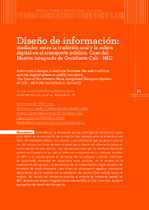| dc.contributor.author | Uribe Orozco, Mario Fernando | |
| dc.coverage.spatial | Seccional Medellín | spa |
| dc.date.accessioned | 2021-01-18T18:57:29Z | |
| dc.date.available | 2021-01-18T18:57:29Z | |
| dc.date.issued | 2014 | |
| dc.identifier.uri | http://hdl.handle.net/20.500.11912/7372 | |
| dc.description | p. 51 - 75 | spa |
| dc.description.abstract | Este artículo se desprende de una investigación doctoral en curso, cuyo objeto es la exploración de la relación que subyace entre la infraestructura física del transporte público, los usuarios y la información que se genera para el uso del servicio, así como también el papel que el diseño de información juega en la articulación de esa relación. Las transformaciones que ha tenido el transporte público en Colombia en los últimos años con la incursión de los sistemas basados en BRT, y en consecuencia, el reemplazo de los antiguos sistemas colectivos, ha ocasionado diversidad de situaciones, unas positivas -en el sentido de la cualificación del servicio y la disminución de la contaminación, según estudios del Ministerio del Medio Ambiente-, pero otras con connotación negativa, como es el descontento de los usuarios por la prestación del servicio. Este estudio busca el análisis del cambio del transporte colectivo al sistema de transporte basado en BRT denominado Masivo Integrado de Occidente MIO, en Cali, Colombia, desde la perspectiva del diseño de información. | spa |
| dc.description.abstract | This paper follows an ongoing doctoral research, aimed at exploring the underlying relationship among the physical infrastructure of public transport users and the information generated for the use of the service, as well as the role that information design plays in the articulation of the relationship. The transformations that public transportation has undergone in Colombia in recent years with the based on BRT systems, and consequently, the replacement of the old collective systems, has led to a variety of situations, some positive in the sense of qualifications of the service and the reduction of pollution, according to studies by the Ministry of Environment-, but others with negative connotations, such as user dissatisfaction for the service. This study aims to examine the change of mass transit transportation system based on BRT called Western Mass Integrated Transport System or MIO, in Cali, Colombia, from the perspective of information design. | spa |
| dc.format.mimetype | application/pdf | |
| dc.language.iso | spa | |
| dc.publisher | Universidad Pontificia Bolivariana | spa |
| dc.relation.ispartof | Iconofacto | spa |
| dc.rights | Attribution-NonCommercial-NoDerivatives 4.0 International | * |
| dc.rights.uri | http://creativecommons.org/licenses/by-nc-nd/4.0/ | * |
| dc.subject | Diseño de información | spa |
| dc.subject | Usuarios | spa |
| dc.subject | Movilidad | spa |
| dc.subject | Diseño centrado en el usuario | spa |
| dc.subject | Información | spa |
| dc.subject | Señalética | spa |
| dc.subject | Information design | spa |
| dc.subject | Design | spa |
| dc.subject | Users | spa |
| dc.subject | User-centered design | spa |
| dc.subject | Information | spa |
| dc.subject | Signposting | spa |
| dc.title | Diseño de información: mediador entre la tradición oral y la esfera digital en el transporte público. Caso del Masivo integrado de Occidente Cali - MIO | spa |
| dc.title.alternative | Information design: a mediator between the oral tradition and the digital sphere in public transport. The Case of the Western Mass Integrated Transport System of Cali – MIO (for its initials in Spanish) | spa |
| dc.type | article | spa |
| dc.rights.accessRights | openAccess | spa |
| dc.type.hasVersion | publishedVersion | spa |
| dc.description.sectional | Medellín | spa |
| dc.identifier.instname | instname:Universidad Pontificia Bolivariana | spa |
| dc.identifier.reponame | reponame:Repositorio Institucional de la Universidad Pontificia Bolivariana | spa |
| dc.identifier.repourl | repourl:https://repository.unab.edu.co/ | |


